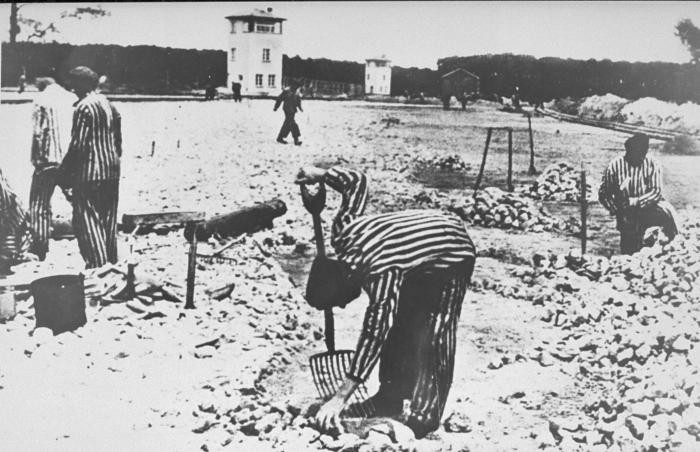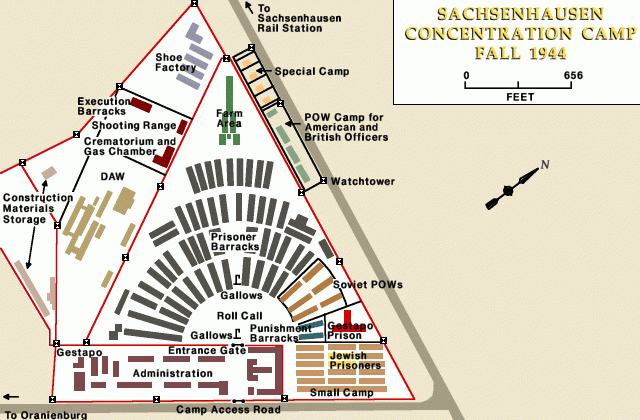
Sachsenhausen: Conditions in the Camp
Between 1933 and 1945, Nazi Germany and its allies established more than 44,000 camps and other incarceration sites (including ghettos). The perpetrators used these locations for a range of purposes, including forced labor, detention of people deemed to be "enemies of the state," and mass murder. Millions of people suffered and died or were killed. Among these sites was the Sachsenhausen camp and its subcamps.
The main camp at Sachsenhausen consisted of a roll-call area, around 50 barracks for prisoners, as well as barracks that served as a washroom, kitchen, infirmary, multiple warehouses, offices, and workshops. Other buildings in the compound included a prison, crematorium, gas chamber (built in 1943), and morgues. The main camp was surrounded by a stone wall over eight feet high, inside of which ran an electrified wire fence. Around the perimeter were nine guard towers.

In the early years of the camp, food rations were meager, but sufficient for most prisoners to survive except perhaps those in the punishment detail, to whom the camp personnel allotted smaller rations. This changed in 1938 as the authorities brought increasing numbers of prisoners to Sachsenhausen, and the amount and quality of the food allotted to each prisoner decreased. By the winter of 1939-1940, prisoners began to starve from insufficient nourishment.
Sanitary conditions in the camp had been primitive from the outset, but worsened still following the outbreak of war. In the last months before the end of the war the death rate increased at an incredible rate. Many prisoners would die in Sachsenhausen due to exhaustion, starvation, exposure, abuse, and lack of medical care.
In April 1941, a commission of SS doctors conducted a "selection" among the prisoners at Sachsenhausen. Over the next three months the commission ordered prisoners too ill or weak to work, as well as prisoners with disabilities, to be killed as part of Operation 14f13, which expanded the so-called Euthanasia Program into the concentration camps.
In June 1941, camp authorities transported 269 prisoners selected under 14f13 to Sonnenstein, a sanitarium equipped with a gas chamber that served as a killing center for people with disabilities living in institutions. German medical professionals gassed these prisoners at Sonnenstein. Camp authorities conducted further selections in October 1942, selecting prisoners they deemed unfit to work and transporting them to the Dachau concentration camp. In 1944 the camp authorities sent "unfit" prisoners to the Bergen-Belsen concentration camp.
German scientists and medical researchers conducted medical experiments on prisoners in Sachsenhausen. SS doctors conducted around 40 different types of experiments, including sterilizations, castrations, experimenting with hepatitis, inserting infectious material into incisions of the muscle, and testing the effects of potassium cyanide, phosphorous and other toxins on the human body. Many prisoners died as a result of such experimentation. Of those who survived, many would have serious health problems or deformities for the rest of their lives. It is unknown how many prisoners SS doctors subjected to such experiments, but as of May 1941, SS doctors had already castrated or sterilized 107 prisoners in Sachsenhausen.
Camp authorities also directly killed prisoners in Sachsenhausen. Shooting was the preferred method of the camp authorities, but the camp also had a gallows in the roll-call area for hanging and was equipped with a gas chamber used for killing small groups of prisoners. All types of prisoners, including Jews, were among those singled out for killings at various times during the camp's operation.
The SS authorities forced the prisoners to perform hard labor. Before the outbreak of the war, camp authorities assigned prisoner work detachments largely to construction and industrial sites in the vicinity of the camp. In the summer of 1938 the SS founded a brickworks company, the German Earth and Stone Works, Ltd. (Deutsche Erd- und Steinwerke (DESt), and forced prisoners to begin construction at a site called Klinkerwerk (brickworks) in the nearby town of Lehnitz. Camp personnel marched 1,500 prisoners to and from the Klinkerwerk each day until the camp authorities decided in 1941 to turn Klinkerwerk into a subcamp of Sachsenhausen and house the prisoners on site. During the war, forced labor utilizing concentration camp prisoners became increasingly important in German armaments production.
As a result, the Sachsenhausen camp system expanded to include more than 40 subcamps concentrated mainly around armaments industries in the greater Berlin area in northern Germany. As of mid-January 1945 there were more than 65,000 prisoners in the Sachsenhausen camp complex, including more than 13,000 women.
Critical Thinking Questions
- To what degree was the local population aware of this camp, its purpose, and the conditions within? How would you begin to research this question?
- Where were camps located?
- Did the outside world have any knowledge about these camps? If so, what, if any, actions were taken by other governments and their officials?
- What choices do countries have to prevent, mediate, or end the mistreatment of imprisoned civilians in other nations?

